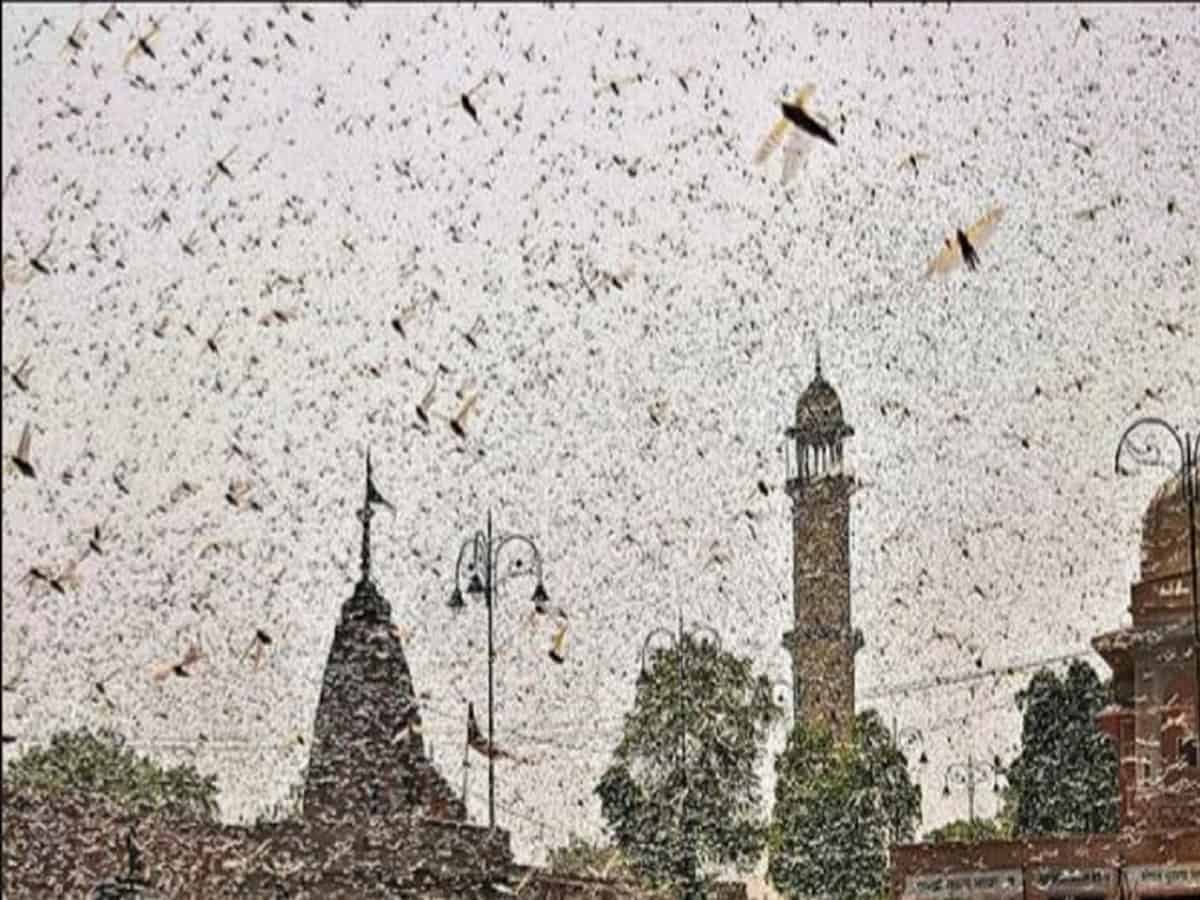Gurugram: The skies over many parts of Gurugram turned dark on Saturday as swarms of locusts descended on the town, but the migratory pests are likely to spare the national capital, for now, officials said.
The dark cloud of locusts spread across two kilometres crossed the suburban city, touched the Delhi-Gurugram border but did not enter Delhi.
“The swarms moved from west to east. They entered Gurugram around 11.30 am,” K L Gurjar of the Locust Warning Organisation, Ministry of Agriculture, told PTI.
The pests, he said, were headed towards Palwal in Haryana.
Alarmed at the invasion of the locusts, which settled on trees, rooftops and plants, many residents of Gurugram shared videos from their high-rise perches.
Swarms of locusts were seen in condominiums such as Beverly Park, Garden Estate and Heritage City as well as buildings in Sikanderpur in the high-rise town bordering Delhi.
IGI Airport
National capital’s IGI Airport has been kept on high alert following swarm of locusts were spotted near to the key installation.
The spotting took place near to national highway 8’s stretch which connects the national capital to Gurugram around 11.00 a.m., sources said.
Accordingly, the airport was kept at high alert as operations could have bee n affected due to the incoming locust swarm.
However, due to a change in wind direction the swarm has moved in a completely different direction altogether.
“As of now operations are completely normal, but we are maintaining a lookout and coordinating with different agencies,” sources said.
District administrations alerted
With swarms of locusts descending on neighbouring Gurugaon, Delhi Environment Minister Gopal Rai on Saturday asked the national capital’s south and west districts’ administrations to remain on high alert, said officials.
According to an official who attended the meeting, the minister was informed that a small swarm of locusts has also reached the Asola Bhatti area in South Delhi.
Drums and dhols to repel swarms
The Agriculture Department has been asked to issue a detailed advisory to all district magistrates and sub-divisional magistrates to deal with a possible locust attack in Delhi.
The minister also asked Forest Department to play DJs, beat drums and dhols to repel the swarms of locusts, the official said.
Rai also asked officials of the Agriculture Department to make field visits to areas close to Gurgaon.
The development secretary, divisional commissioner, director, agriculture department and district magistrates of South Delhi and West Delhi attended the meeting, the official said.
The swarms of locusts, spread across two kilometres, moved from west to east. They entered Gurgaon around 11.30 am, K L Gurjar of the Locust Warning Organisation, the Ministry of Agriculture, told PTI.
The pests, he said, were headed towards Faridabad and Palwal in Haryana.
Videos surfaced
Alarmed at the invasion by locusts, which settled on trees, rooftops and plants, many residents of Gurugram shared videos from their high-rise perches.
In May, India battled a devastating desert locust outbreak. The crop-destroying swarms first attacked Rajasthan and then spread to Punjab, Gujarat, Maharashtra and Madhya Pradesh.
According to experts, broadly four species of locusts are found in India — desert locust, migratory locust, Bombay locust and tree locust. The desert locust is considered the most destructive.
It multiplies very rapidly and is capable of covering 150 kilometers in a day.
This insect, a type of a grasshopper, can eat more than its body weight. A one square kilometer of locust swarm containing around 40 million locusts can in a day eat as much food as 35,000 people.
Experts blame the growing menace of desert locusts on climate change. They say breeding of locusts is directly related to soil moisture and food availability.
In May, India battled a devastating desert locust outbreak. The crop-destroying swarms first attacked Rajasthan and then spread to Punjab, Gujarat, Maharashtra and Madhya Pradesh.

